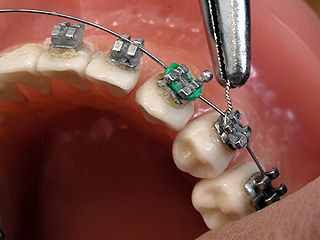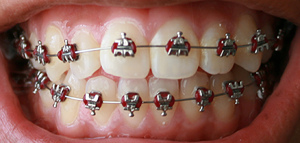
Orthodontics is a specialty of dentistry that deals with the diagnosis, prevention, and correction of malpositioned teeth and jaws, and misaligned bite patterns. It can also focus on modifying facial growth, known as dentofacial orthopedics.

A malocclusion is a misalignment or incorrect relation between the teeth of the two dental arches when they approach each other as the jaws close. The term was coined by Edward Angle, the "father of modern orthodontics", as a derivative of occlusion. This refers to the manner in which opposing teeth meet.

An archwire in orthodontics is a wire conforming to the alveolar or dental arch that can be used with dental braces as a source of force in correcting irregularities in the position of the teeth. An archwire can also be used to maintain existing dental positions; in this case it has a retentive purpose.

Dr. Ravindra Nanda is a professor and Head of the Department of Craniofacial Sciences and Chair of the Division of Orthodontics at the University of Connecticut School of Dental Medicine. He is part of the founding faculty of School of Dental Medicine and has been at the University of Connecticut since 1972 where he also holds an Alumni Chair in the Orthodontics Division. He is an innovator of various appliances in orthodontics. His research and clinical interests include adolescent and adult orthodontics, the biology of tooth mobility, craniofacial orthopedics, biomechanics and developing efficient mechanics to deliver orthodontic care.
Erik Arne Björk was a Swedish dentist famous for his The Face in Profile Analysis which he published in 1947. He is also known to develop the implant radiography.
Dr. Martin Dewey (1881–1933) was an American orthodontist and a past president of the American Association of Orthodontists and the American Dental Association. Dewey represented the "New School" of Edward Angle in the great Extraction Debate of 1911 held in New York City.
Wendell L. Wylie was an American Orthodontist who served as a President of American Board of Orthodontics and the Chief Editor for The Angle Orthodontist Journal.
David L. Turpin is an American Orthodontist who was the Editor-in Chief for The Angle Orthodontist from 1988 to 1999 and American Journal of Orthodontics and Dentofacial Orthopedics from 1999 to 2010.
Thomas M. Graber was an American orthodontist known for his contributions to the field of orthodontics. Graber wrote 28 books on orthodontics and dental anatomy. He also wrote chapters in more than 20 books and over 175 published articles.
Jacob Amos Salzmann (1901–1992) was an American orthodontist who is known for developing an assessment index for determining malocclusion. This index has been adopted by ADA Council of Dental Health, the Council on Dental Care Programs, and by the American Association of Orthodontists.
Frederick Lester Stanton was an American orthodontist who played a key role in forming of first specialized dental journal The American Orthodontist and formation of the Hanau Articulator with Rudolph L. Hanau. He also attended Angle School of Orthodontia and graduated from there in 1905.
Dr. Spencer Roane Atkinson was an American orthodontist and a graduate of Angle School of Orthodontia. He is best known for establishing The Spencer R. Atkinson Library of Applied Anatomy at University of the Pacific Arthur A. Dugoni School of Dentistry. The library consists of collection of 1,400 human skulls collected over past 40 years. Atkinson is also known for developing the Universal Appliance in the 1960s which led to eventual formation of the Unitek Division of 3M Company.
Dr. Calvin Suveril Case was an American orthodontist who is known to be one of the earliest prominent figures in Orthodontics. Dr. Case did extensive work with Cleft Lip and Palate and is known to develop Velum Obturator. Dr. Case is famously known for his part in the Extraction Debate of 1911 that happened between Dr. Edward Angle and Dr. Case.
Benno Edward Lischer was an American orthodontist who at one point was the President of American Association of Dental Schools and American Association of Orthodontists. He was the first full-time dean at Washington University School of Dental Medicine.
Dr. Samir Bishara was an Orthodontist from Egypt who received the highest honor from the World Federation of Orthodontists when they selected him to be the honorary fellow of the WFO.
Dr. Herbert A. Pullen was an American Orthodontist who was the graduate of the first class from Angle School of Orthodontia in 1900. Dr. Pullen is known to develop Pullen band-forming plier, band-removing plier and band seater.
Harold Chapman was a British orthodontist who was England's first exclusive orthodontic practitioner in 1921. He was also the President of the European Orthodontic Society and British Dental Association during his career.
Alfred Paul Rogers was an American Orthodontist who was considered as the Father of the Myofunctional Therapy in Orthodontics. He was the President of American Association of Orthodontists and American Academy of Dental Sciences. He was also instrumental in forming the American Board of Orthodontics.
Lysle E. Johnston Jr. is an American orthodontist.
Orthodontic indices are one of the tools that are available for orthodontists to grade and assess malocclusion. Orthodontic indices can be useful for an epidemiologist to analyse prevalence and severity of malocclusion in any population.



